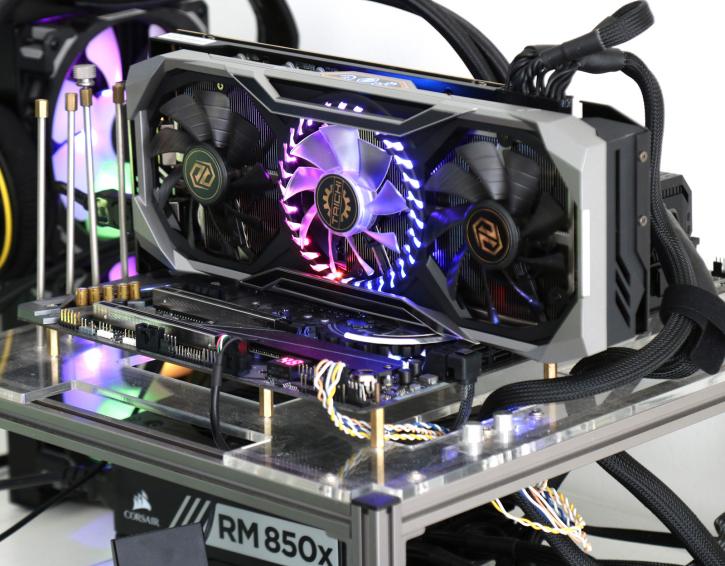Introduction
ASRock Radeon RX 5700 XT Taichi OC+
New looks, new acoustics, yin, and yang.
ASRock is going a bit more premium with their all-new Radeon RX 5700 XT Taichi, in specific we test the OC+ edition. It has the best clocks, new looks, and silent acoustic levels. Fabricated at a 7nm node and capable of battling with NVIDIA's GeForce RTX 2060 and 2070 we'll check out how well it holds against the reference card as well. The card has a few interesting features, for example, it holds four DisplayPort connectors as well as two HDMI ports. The Taichi OC+ has a 2.7-slot design and was fitted with three fans and two 8-pin power headers, a full cover backplate is kept in style with X570 Taichi motherboards.
It has been quite a journey for AMD, but it is the year 2019 and the chip producing industry is ready with their new silicon wafer fabrication at 7nm. AMD hasn't been wasting any time, Ryzen 3000 at 7nm, Radeon VII at 7nm, and today we bring you a review of both the Radeon 5700 and 5700 XT. The basis of the product that we test today is the NAVI GPU, with a die fabbed at a 7nm fabricated package and 8GB of GDDR6 graphics memory these cards are released in an aim to compete with the GeForce RTX 2060 and 2070, will it be capable to do that? We can already tell you that the numbers will be interesting to see. The most important aspect, however, is pricing. AMD wanted to tackle two price points for NAVI, for the familiar frame of mind let's call the Radeon RX 5700 the PRO revision and then the Radeon RX 5700 XT GPU versions. So the new Radeon RX 5700 and 5700 XT will cost 349 and 399 USD respectively. As we all know NAVI is the new family of mainstream to high-end (but not enthusiast) Radeon GPUs. NAVI is based on what AMD refers to as RDNA architecture (Radeon DNA). The Radeon 5700 series will also be the first commercial consumer graphics card that is PCIe Express 4.0 compatible. AMD today will launch the reference products, the AIB card with custom designs and cooling will follow in the weeks to come. Reference first though, Radeon 5700 is a GPU with 2304 stream processors. The GPU game clock is dynamic at 1.6 GHz with a peak boost clock to 1.7 GHz. It's bigger brother is the Radeon RX 5700 XT, with a fully enabled NAVI chip it has 2560 shader processors active. Its average game clock will hover in the 1.75 GHz but can boost to 1.9 GHz. We do wish AMD would not make a distinction between a game and max boost clock though as it is just too confusing for the majority of consumers. Both NAVI cards are fitted with GDDR6 memory, that means HBM2 is no longer used opposed to what you have been seeing with Vega 56/64, a clever choice as HBM2 memory is difficult to assemble onto the die substrate (lot's of yield issues there) and that makes it very expensive, next to being an expensive memory type to purchase. What AMD did well is that they have opted that 8GB GDDR6 graphics memory to run at 14 Gbps, which is nice and fast graphics memory at just the right volume size.
ASRock Radeon RX 5700 XT Taichi OC+
The Taichi OC+ has a newly updated style cooler combining a mix of black and gunmetal grey with a brushed metal backplate and gears to match that Tachi line of products. The Tachi is fitted with triple fans based on a Zero DBa mode design, that means below 60 Degrees C the fans do not spin. The RX 5700 XT will get two 8-pin PCIe power connectors and connectivity wise it looks to become four DisplayPort outputs and two HDMI ports. ASRock also allowing the clock frequencies to max boost towards a frequency of 2025 MHz and a game clock of 1935 MHz, which is a significant increase over the AMD reference design. The max boost is a bit of a confusing value as the game clock is what it really is all about. Our measurements show that value running in the ~1935 and 2000 MHz range based on your BIOS preset, as yes the card offers a 'silent mode' BIOS with slightly more conservative (reference) settings and clocks. We have a lot to talk about, have a peek at what is reviewed today. One the next two pages some in-house photos, after which we then head onwards into the review. Oh, and did I already mention she's pretty?


